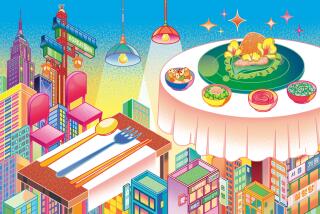Discovering Seoul, one subway stop at a time
Reporting from Seoul — The question has popped into the minds of most subway commuters, only to vanish amid the chaos of the workaday rush: “What if I just got off here?”
But for Charles Usher, that idle thought launched an ambitious blog project to describe the intricacies of Seoul one subway stop at a time — all 477 of them. He wanted to pierce the prevailing urban sameness of his adopted hometown, areas dominated by high-rise apartments and chain outlets.
On a recent Sunday, he headed out to the byzantine subway system dressed in a white shirt with a colorful koi fish on one shoulder, cargo shorts and pink sneakers. Notebook in hand, he resembled a cross between tourist and bespectacled inspector.
Usher is utilitarian in choosing his subway stops: Each has an official number, a designation that starts with the line and then the sequential stops. He enters the digit range into a random numbers-generator program on his computer, going with what’s chosen.
On this day, the number turns out to be 746: the Gasan Digital Complex station, the 46th stop on line 7.
For Usher, 28, a Wisconsin-born writer and magazine editor who teaches English here, Seoul’s subway stops are doors to uncharted neighborhoods, strange lives and often-confounding architecture.
His blog, Seoul Sub-urban, aims to show the casual commuter how, rather than being maddeningly similar, many stations and their environs provide their own unique urban landscape.
Residents of car-manic Los Angeles most often view their domains through the prism of freeway interchanges and exits, but in a compact city such as Seoul, the subway’s far-reaching and well-traveled arteries serve as the geographic guideposts, he says.
Usher began the blog last year after returning to Seoul from a trip around Southeast Asia, this time pledging to himself to expand his knowledge of the city of 10 million people.
“It bugged me that I’d lived in Seoul for a year and hadn’t seen that much of the city,” he said. “Seoul has a good subway system, so it made perfect sense to use that to expand my haunts.”
The blog, subtitled “Discovering Seoul, one subway stop at a time,” contains impromptu postings in which the introspective Usher describes his amblings. “It’s a big city,” the site challenges. “Get on the train.”
Near one station, Usher writes, he found “an old man on the sidewalk who had a machine that air-puffed rice to make bar snacks attached to the back of a motorcycle. Every so often it would emit a loud bang and scare any nearby dogs whose owners had taken them out for a walk.”
He later encounters some abandoned houses and wanders about, letting his curiosity roam, “peeking through cracks and broken windows … stepping through the occasional door that had been left open.” He imagines the lives of former residents by the detritus left behind: “A bookshelf, a bike, a laundry basket, a dish rack, pillows and blankets, boots, a ‘Dora the Explorer’ videotape.”
Usher’s website lists brief biographies of himself and photographer Liz Groeschen, along with the local subway station of each. There are nuggets of information about the Seoul metro — that it’s the world’s third busiest, serving 6 million passengers a day, covering 400 miles along 20 lines.
Some stops are set among old-school Korean neighborhoods with markets and crowded alleyways. Others are more typical of the modern urban wasteland, dominated by ubiquitous skyscrapers. That’s when the chronicling gets challenging.
“It forces you to look deeper,” explains Groeschen, a freelance photographer who studied at the Art Institute of Chicago.
The two subway trippers and a second photographer, Angelique Kuyper, stand outside the station, located at the confluence of subway lines 1 and 7, and examine a hand-drawn schematic of the surrounding area.
“There’s a big IT campus and a fashion town with clothing outlets,” Usher announces.
“I vote fashion,” Groeschen says, and they’re off, each lost in their own worlds of observation.
They pass a garish mall. “Lots of pink,” Usher scoffs.
“Matches your shoes,” Groeschen shoots back.
They wander down several trash-strewn alleys, past sidewalk clothing racks. With limited Korean, Usher often hesitates to approach residents to get their take on things.
Then the trio comes upon a small crowd on the sidewalk. As Usher starts past, a stranger leans close to gesture that a vendor is handing out free slices of watermelon on the humid afternoon.
Later, Usher walks away with his fruit, an urban observer who is suddenly part of the neighborhood.
john.glionna@latimes.com
More to Read
Sign up for Essential California
The most important California stories and recommendations in your inbox every morning.
You may occasionally receive promotional content from the Los Angeles Times.










